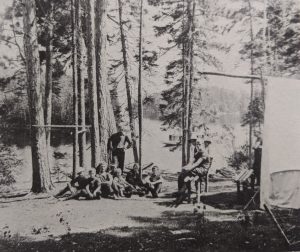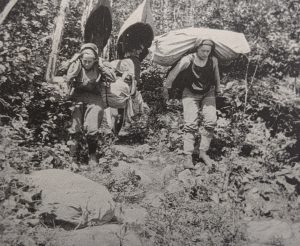The Ontario youth summer camp movement developed within of the unique historical moment of the late nineteenth century, as North Americans on both sides of the border grappled with the socially disruptive forces of industrialization and urbanization. In previous eras, the North American landscape had represented a hostile and untamed environment, rich with opportunities for cultivation and financial exploits, but as the century ended, both Canadian and American perceptions of the backcountry shifted—the wilderness became a place for overcivilized city folk to return to a simpler time of virgin landscapes and undisturbed leisure. This antimodernist impulse for the out-of-doors, coupled with increased interest in the development and shaping of urban youth, led to the creation of the North American summer camp. The early camping movement established institutions that served distinct classed populations, such as fresh air camps for the urban poor, and agency camps for the urban middle-class.1
Private Camps for Boys

Within the Ontario camping movement of the turn of the twentieth century, private wilderness canoe tripping camps for boys and young men emerged as the most elite camping institutions. Private canoe tripping camps developed exclusive communities of upper class and upwardly mobile middle class white, protestant boys and men. Such camps charged high fees and were often located in the most desirable and isolated lake regions, such as Temagami and Algonquin Park. These camps’ exclusive cultures were reinforced by long camp sessions (some as long as eight weeks) that would generate returning campers year after year, many of whom continued to work as camp staffmen and administrators in their adulthood. Indeed, a man’s relationship with a camp often continued into multiple family generations, with sons, nephews, and grandsons attending the same camp. Many such camps were further associated with private boarding and preparatory schools and served as natural summer options for many male students. In this way, private canoe tripping camps developed tight-knit and exclusive communities of elite families that lasted for generations, many of them still existing today.2
Wilderness Canoe Tripping Camps

The wilderness canoe trip was central to the private camp experience. Extended canoe trips in the Canadian backcountry allowed young white men to shirk the feminizing pressures of urban life and engage in rugged adventures that toughened them up, making boys into men. Enduring the physically demanding activities of paddling and portaging built character, while tripping in a small, isolated group emphasized cooperation and good citizenship, making wilderness canoe tripping the perfect setting for molding resilient and resourceful young men.3 Canoeing further opened doors for young men to access what they perceived to be the primitive and unspoiled culture of Native American peoples of the region in vogue at the turn of the century. At the same time, private camps emphasized social etiquette associated with elite gentlemanliness; boys were not only expected to exhibit proper dress, table manners, and grooming, but also demonstrate decorum, respect, and good sportsmanship.4
Works Cited
- Sharon Wall, “Introduction,” in The Nurture of Nature: Childhood, Antimodernism, and Ontario Summer Camps, 1920-55 (Vancouver: UBC Press, 2009), 3-25.
- Sharon Wall, “Socialism for the Rich: Class Formation at the Private Camp,” in The Nurture of Nature: Childhood, Antimodernism, and Ontario Summer Camps, 1920-55 (Vancouver: UBC Press, 2009), 63-101.
- Sharon Wall, “Socialism for the Rich: Class Formation at the Private Camp,” in The Nurture of Nature: Childhood, Antimodernism, and Ontario Summer Camps, 1920-55 (Vancouver: UBC Press, 2009), 73.
- Sharon Wall, “Socialism for the Rich: Class Formation at the Private Camp,” in The Nurture of Nature: Childhood, Antimodernism, and Ontario Summer Camps, 1920-55 (Vancouver: UBC Press, 2009), 63-101.